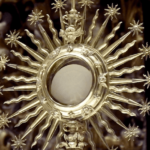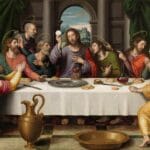The Tabernacle: A portable sanctuary, meticulously designed by God, served as the earthly dwelling place of His presence among the Israelites during their wilderness journey. Journey from the Outer Court to the Holy of Holies: Discover the layered symbolism of the Tabernacle, revealing God’s holiness and humanity’s path to atonement. More than just a tent: The Tabernacle’s intricate details, from the Ark of the Covenant to the bronze altar, prefigured Christ’s role as the ultimate mediator and sacrifice. Unlock the secrets of the Tabernacle: Explore its construction, furniture, and rituals to gain a deeper understanding of God’s covenant relationship with His people.
Exploring the Tabernacle’s Design
The tabernacle diagram is like a treasure map, guiding us through God’s dwelling place among the ancient Israelites. Imagine a portable, sacred tent meticulously crafted according to God’s instructions—a potent symbol of His holiness and desire for closeness with His people. This visual representation of the divine-human relationship wasn’t just a tent; it was a structured sanctuary. Let’s explore its layout:
The Outer Courtyard: First Steps Towards the Sacred
The Outer Court, enclosed by linen curtains, was the initial entry point, accessible to all Israelites. This was where they brought offerings and prepared for worship, taking their first steps toward the divine. Two key features stood out:
The Bronze Altar of Burnt Offering: Here, animal sacrifices symbolized atonement for sins, acknowledging imperfections and seeking reconciliation with God. It might have served as a powerful visual reminder of the cost of sin.
The Laver: Before proceeding, priests washed their hands and feet in the laver, a practice that probably symbolized spiritual purity before approaching God. This suggests preparation was necessary even for those designated to serve God. The enclosure itself, made of linen curtains hung on bronze pillars (Exodus 27:9-19), measured 100 cubits long and 50 cubits wide, creating a distinct boundary between the sacred and the everyday.
The Holy Place: A Deeper Level of Communion
Beyond the Outer Court, separated by an embroidered curtain, lay the Holy Place, accessible only to priests. This space, reserved for deeper communion, housed three significant objects:
The Golden Lampstand (Menorah): With its seven branches, the Menorah likely symbolized God’s constant presence, illuminating the path (Exodus 25:31-40). The light may also have represented knowledge and truth.
The Table of Showbread: Twelve loaves, representing the twelve tribes of Israel (Exodus 25:23-30), were placed here, suggesting God’s provision and covenant. It’s like a symbolic meal shared between God and Israel.
The Altar of Incense: The burning of fragrant incense, its rising smoke, probably symbolized prayers ascending to God (Exodus 30:1-10). Imagine the aroma carrying the Israelites’ hopes heavenward.
The Holy of Holies: The Heart of God’s Presence
Hidden behind a thick, cherubim-embroidered veil (Exodus 26:31-33) was the Holy of Holies, the most sacred space. Accessible only to the High Priest once a year on the Day of Atonement, it represented God’s dwelling place on earth. Here resided:
The Ark of the Covenant: This gold-covered chest (Exodus 25:10-22) held the Ten Commandments, symbolizing God’s covenant and authority.
The Mercy Seat: The solid gold lid atop the Ark, where the High Priest sprinkled sacrificial blood, suggests atonement and forgiveness. Some scholars believe it represented God’s throne.
Constructing the Tabernacle: A Divine Collaboration
Skilled craftsmen like Bezalel and Oholiab, divinely inspired and guided (Exodus 31:1-11), constructed the Tabernacle. Symbolic materials—gold representing purity, acacia wood durability, and linen holiness—were used. The meticulous design suggests intentionality in every element, a testament to the reverence for God’s presence.
The Tabernacle’s Enduring Significance
The tabernacle diagram is not just a blueprint; it’s a visual story of God’s desire for a relationship with humanity. It represents the Israelites’ journey, their reliance on God, and may even foreshadow Jesus Christ as the ultimate dwelling place of God among humans. Ongoing research and diverse interpretations enrich our understanding of this fascinating structure. Do you believe satan summoning his legions? Have you ever seen a true miracle? Check out the absolution of gettysburg. While much is understood, there’s still much to discover. As you explore, remember the profound relationship it represents.
Delving into the Tabernacle’s Parts
Let’s unpack the specific components of this portable sanctuary—a divine mobile home designed by God, meticulously planned and rich with meaning. It symbolized God’s presence among his people, serving as a blueprint for the ultimate dwelling place of God – within us. Divided into three main sections—Outer Court, Holy Place, and Holy of Holies—each had a unique purpose.
The Outer Court: Welcoming All
Accessible to all Israelites, the Outer Court was where offerings were brought and worship began. Two key features were:
The Altar of Burnt Offering: Located at the entrance (Exodus 27:1-8), animal sacrifices here symbolized atonement, a reminder of sin’s cost and the need for forgiveness.
The Laver: This bronze basin (Exodus 30:17-21) held water for priestly cleansing, symbolizing the spiritual purity needed to approach God.
The Holy Place: Approaching the Divine
Reserved for priests, the Holy Place contained three important items:
The Golden Lampstand (Menorah): Providing constant light (Exodus 25:31-40), it symbolized God’s perpetual presence, guiding His people.
The Table of Showbread: Twelve loaves of bread (Exodus 25:23-30), representing the twelve tribes, symbolized God’s provision and the covenant with Israel.
The Altar of Incense: Incense burned here (Exodus 30:1-10), its rising smoke symbolizing prayers ascending to God, a tangible link between earthly and heavenly realms.
The Holy of Holies: The Innermost Sanctuary
Accessible only to the High Priest on the Day of Atonement, this most sacred area housed:
The Ark of the Covenant: This ornate chest (Exodus 25:10-22) contained the Ten Commandments, symbolizing God’s covenant with Israel.
The Mercy Seat: The golden lid covering the Ark (Exodus 25:17-22), where the High Priest sprinkled blood, signified atonement. This is where God’s presence was most strongly felt.
The Tabernacle represents God’s desire to dwell among His people. While its physical structure is gone, its symbolic meaning endures, offering insights into God and His relationship with humanity. Ongoing research and scholarly debate continue to illuminate its deeper significance.
Understanding the Tabernacle’s Layout
The Tabernacle, a divinely inspired pop-up sanctuary, served as the Israelites’ mobile meeting place with God during their wilderness journey. Its design, detailed in Exodus chapters 25-40, wasn’t merely practical but deeply symbolic, a spiritual roadmap towards God.
Imagine distinct zones of holiness: the Outer Court, accessible to all; the Holy Place, reserved for priests; and the Holy of Holies, entered only by the High Priest once a year. Each piece within held symbolic weight.
The Outer Court housed the Altar of Burnt Offering for sacrifices and the Laver for purification. The Holy Place held the Menorah, symbolizing guidance; the Table of Showbread, representing provision; and the Altar of Incense, a place of prayer. The Holy of Holies contained the Ark of the Covenant, holding the Ten Commandments, and the Mercy Seat, where God’s presence manifested, symbolizing the divine covenant.
Scholarly interpretations of the layout and symbolism vary, with ongoing research illuminating details. We rely on ancient texts and archaeological findings, subject to reinterpretation. This uncertainty adds intrigue to the study. As a living center of Israelite faith, the Tabernacle offers insight into their beliefs, rituals, and relationship with God. This portable sanctuary, designed to be easily disassembled and transported (Exodus 25:8), facilitated God’s presence during their travels. The divinely prescribed materials, including gold, silver, bronze, acacia wood, and various fabrics, each held symbolic meaning. Exodus 26 details the dimensions, construction, and arrangement, crucial for understanding the layout. The veil’s tearing at Jesus’ crucifixion (Matthew 27:51) symbolized access to God for all believers.
| Feature | Location | Significance |
|---|---|---|
| Outer Court | Outside | Accessible to all, first step towards God |
| Altar of Burnt Offering | Outer Court | Atonement for sin |
| Laver | Outer Court | Purification |
| Holy Place | Inside | Priest access only |
| Menorah | Holy Place | God’s light and guidance |
| Table of Showbread | Holy Place | God’s provision |
| Altar of Incense | Holy Place | Prayer |
| Holy of Holies | Innermost | High Priest access only, once a year |
| Ark of the Covenant | Holy of Holies | God’s presence, covenant |
This table summarizes the layout. Further exploration reveals fascinating details about this structure’s role in Israelite history and faith.
Defining the Tabernacle Biblically
The Tabernacle (Hebrew: מִשְׁכַּן, miškan, “residence”), also known as the Tent of the Congregation (אֹהֶל מוֹעֵד, ʔōhel mōʕēḏ, “Tent of Meeting”), was God’s ordained dwelling place among the Israelites (Exodus 25:8). This portable, three-part structure—Outer Court, Holy Place, and Holy of Holies—represented a journey from the everyday to the divine.
The Outer Court, accessible to all, was the initial approach to God. The Holy Place, for priests only, housed the golden lampstand, table of showbread, and altar of incense, each rich with symbolic meaning. The Holy of Holies, accessible only to the High Priest annually on the Day of Atonement, contained the Ark of the Covenant, symbolizing God’s presence.
Scholarly opinions vary on the Tabernacle’s design origins, attributing it to both existing tent structures and divine inspiration. Research continues to explore the symbolism of each element, yielding new interpretations.
| Tabernacle Section | Access | Significance | Key Items |
|---|---|---|---|
| Outer Court | All Israelites | Initial approach, offering sacrifices | Altar of Burnt Offering, Laver |
| Holy Place | Priests only | Deeper communion, priestly duties | Menorah, Showbread Table, Incense Altar |
| Holy of Holies | High Priest only | Ultimate presence of God, atonement rituals | Ark of the Covenant |
Our understanding of the Tabernacle is ever-evolving. Basic structure and function are known, but deeper symbolism remains open to interpretation. Some believe it foreshadowed Jesus, the ultimate dwelling place of God. This complex topic invites exploration.
The Tabernacle symbolizes God’s presence among His people, a place for connection amid uncertainty. It acts as a metaphor for our spiritual journeys toward God, prompting us to create “sacred spaces” in our lives. It was used from the Exodus to Canaan’s conquest, with specific details in Exodus 25-27, 30-31, 35-40, Numbers, and more. God’s command for its construction shows His desire for communion, and its portability symbolized His guidance throughout the wilderness journey. Meticulous instructions highlight its sanctity, and it prefigures Christ and God’s heavenly dwelling. The Tabernacle was the Israelites’ hub for worship, prefiguring both the temple and the Christian church. Consider how it might have impacted their sense of identity. How does the Church fulfill and expand upon its purpose? How does it differ from pagan worship spaces? Explore its story as one of a relationship, not just a structure.
- Senior at What Age: Benefits & Eligibility Guide - March 29, 2025
- Unlocking Senior Benefits: How Old is a Senior? Your Complete Guide - March 29, 2025
- Master Russian Politeness:A Guide to Saying Please - March 29, 2025
















2 thoughts on “Unlocking the Mysteries of the Tabernacle Diagram: A Visual Guide to God’s Dwelling Place”
Comments are closed.